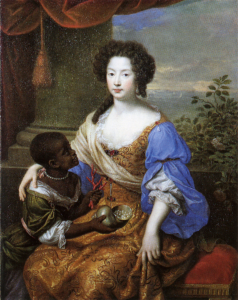Remarks offered in response to “Images and (Re)figurations of Race and Historical Representation” at The Graduate Center’s Currents of the Black Atlantic conference. Papers referred to:
- Emily T. Bauman, “Black Atlantic, White Zombie”
- Elena C. Munoz, “The Significance of the Black Madonna and the Orisha Yemaya in Cuban Plantation Culture”
- Lauren Bailey,”The Object of ‘[T]rue Luster and Whiteness’: The Racialized Beauty of Oriental Pearls in Early Modern England”
I’d like to frame my brief remarks as an invitation for us all to think more about some of the common themes that emerged from these exciting papers. Perhaps I should have been less surprised by the preoccupation with whiteness in these projects: in Emily’s analysis of whiteface, Elena’s discussion of blanqueamiento, and Lauren’s reading of pearls as a metonym for whiteness, imperial power, and feminine beauty. More specifically even, in both Emily and Lauren’s work, whiteness is discussed as a form of artifice, prosthetic, and masquerade, which importantly denaturalizes the binary of whiteness as norm and blackness as other.
In trying to account for the recurrent theme of whiteness among papers at a Black Atlantic conference, I’m curious as to whether this trope is related to the fact that these papers each engage visual culture. For me, the most striking images discussed in these papers place black and white bodies together in the same frame, revealing the way in which white privilege has historically been both bolstered and complicated by visual representations. Here I’m thinking of the painting of a European woman whose beauty is meant to be accented by the presence of a black child, the Afro-Cuban Virgin of Regla cradling a white Jesus, and the black protagonists fighting off hyper-white zombies. These power dynamics in shared spaces reminded me of Sarah Ahmed’s essay, “A Phenomenology of Whiteness” which suggests that “Whiteness could be described as an ongoing and unfinished history, which orientates bodies in specific directions, affecting how they ‘take up’ space, and what they ‘can do’.”
After reading and listening to these papers, I was struck by the two inversely racialized images of the women with children, offered by Lauren and Elena. In trying to wrap my head around the fact that they were produced merely fourteen years apart, in what feels like two different worlds, I was reminded of Gilroy’s Black Atlantic and the way in which it continues to challenge our spatiotemporal imaginaries. These complex images, which immediately invite us to interrogate locally-specific conditions of race, class, and gender, also tempt us to make transatlantic connections regarding processes of racial representation. For me, the question becomes then, how do we attend to this temptation to read these two images alongside one another, in a way that is responsible to their historical specificities? To then think these projects alongside Emily’s work on (relatively) contemporary American zombie films would require an even more radical exercise of our imagination, which we need not shy away from.
Left: Our Lady of Regla (1696) Right: Pierre Mignard, Louise Renee de Kerouaille (1682)
In addition to inviting more discussion regarding the study of visual representations of the Black Atlantic, I’d also be interested in hearing about the panelists’ experiences working with texts drawn from popular culture. Here, I’m specifically thinking about Lauren’s makeup ads and Emily’s Hollywood zombie films. Whereas both of these examples market racial representations to consumer audiences, Elena’s archive of iconography seems to invoke the “popular” in a different sense. What kind of work, then, does a category like the “popular” do in Black Atlantic study?
And finally, I would also add the space of ocean to this list of things we might potentially talk about. Whereas oceans seem crucial both to Lauren’s analysis of pearls as a gendered, racialized, and imperial commodity and to Elena’s description of the enslaved Yoruba being transported to Cuba, it almost seems impossible to imagine Emily’s whiteface zombies at sea, perhaps because zombies seem like such profoundly terrestrial creatures, at least in my experience. And yet Emily’s analysis is grounded in the zombie’s transformations that occurred during its sea-voyages from Haiti to America. Through their emphases on oceanic routes (with a “u”), each of these these papers testifies to the porousness of national boundaries, reminding me of Gilroy’s own very visual image of the nation-state as an overflowing container.



